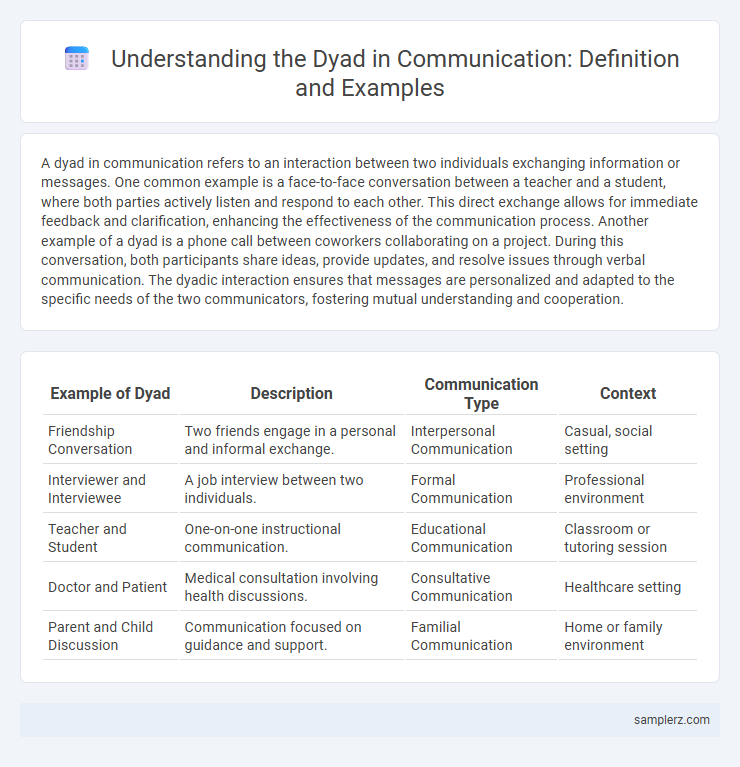A dyad in communication refers to an interaction between two individuals exchanging information or messages. One common example is a face-to-face conversation between a teacher and a student, where both parties actively listen and respond to each other. This direct exchange allows for immediate feedback and clarification, enhancing the effectiveness of the communication process. Another example of a dyad is a phone call between coworkers collaborating on a project. During this conversation, both participants share ideas, provide updates, and resolve issues through verbal communication. The dyadic interaction ensures that messages are personalized and adapted to the specific needs of the two communicators, fostering mutual understanding and cooperation.
Table of Comparison
| Example of Dyad | Description | Communication Type | Context |
|---|---|---|---|
| Friendship Conversation | Two friends engage in a personal and informal exchange. | Interpersonal Communication | Casual, social setting |
| Interviewer and Interviewee | A job interview between two individuals. | Formal Communication | Professional environment |
| Teacher and Student | One-on-one instructional communication. | Educational Communication | Classroom or tutoring session |
| Doctor and Patient | Medical consultation involving health discussions. | Consultative Communication | Healthcare setting |
| Parent and Child Discussion | Communication focused on guidance and support. | Familial Communication | Home or family environment |
Defining Dyadic Communication
Dyadic communication refers to the interactive exchange of information between two individuals, forming the simplest and most direct form of interpersonal communication. A classic example of dyadic communication is a one-on-one conversation between two colleagues discussing a project update, where both participants actively engage in sharing ideas and feedback. This communication style is essential for building trust, understanding, and collaboration in personal and professional relationships.
Key Features of Dyadic Interactions
A dyad in communication involves two individuals engaging in direct, face-to-face interaction characterized by mutual influence and immediate feedback. Key features of dyadic interactions include verbal and nonverbal exchanges that allow for personal connection, shared meaning, and negotiation of roles within the communication process. This two-person dynamic fosters intimacy and trust, essential for effective interpersonal communication.
Classic Examples of Dyads in Communication
A classic example of a dyad in communication is a face-to-face conversation between two individuals, where nonverbal cues and immediate feedback play crucial roles in message interpretation. Another well-known dyadic communication occurs in a one-on-one interview setting, facilitating direct information exchange and personalized interaction. These dyads emphasize intimate, two-person exchanges essential for understanding interpersonal communication dynamics.
Dyad Communication in Everyday Life
Dyad communication in everyday life occurs when two people engage in a direct and personal exchange, such as a conversation between close friends or a phone call with a family member. This form of interaction allows for immediate feedback, emotional bonding, and the exchange of detailed information, making it essential for building trust and understanding. Examples include one-on-one meetings, intimate discussions, and counseling sessions where the dyadic nature enhances clarity and connection.
Dyads in Professional Settings
Dyads in professional settings often involve one-on-one communication between a manager and an employee during performance reviews, facilitating personalized feedback and goal setting. Another common example is the interaction between a client and a consultant, where clear and effective communication ensures project alignment and client satisfaction. These dyadic exchanges enhance collaboration and decision-making within organizations.
Digital Dyadic Communication: Modern Examples
Digital dyadic communication involves direct, two-person interactions through platforms such as instant messaging apps like WhatsApp and social media direct messaging on Instagram. Video calls using Zoom or FaceTime also represent digital dyads, enabling face-to-face interaction despite physical distance. These modern examples highlight how technology facilitates intimate, real-time exchanges in personal and professional contexts.
Challenges in Dyadic Exchanges
Dyadic communication involves two individuals engaging in an exchange, often facing challenges such as misinterpretation of nonverbal cues and emotional barriers that hinder effective understanding. Power imbalances and conflicting communication styles frequently disrupt the flow of dialogue, causing misunderstandings or tension. Successful dyads require active listening and empathy to overcome these obstacles and foster clear, meaningful interactions.
Nonverbal Elements in Dyadic Communication
Nonverbal elements in dyadic communication, such as facial expressions, eye contact, and gestures, play a crucial role in conveying emotions and intentions between two individuals. These nonverbal cues enhance message clarity and foster understanding in face-to-face interactions. Proxemics and body language further influence the dynamics by regulating intimacy and engagement within the dyad.
Role of Feedback in Dyadic Conversations
In dyadic communication, feedback serves as a crucial mechanism for ensuring mutual understanding and effective message exchange between two participants. Real-time responses, such as verbal affirmations or nonverbal cues, enable interlocutors to adjust their messages and clarify intentions, minimizing misunderstandings. The continuous loop of feedback strengthens interpersonal connection and facilitates the negotiation of meaning within the conversation.
Enhancing Effectiveness in Dyad Communication
A dyad in communication typically involves two individuals engaging in direct interaction, such as a teacher and student or a doctor and patient. Enhancing effectiveness in dyad communication can be achieved through active listening, clear verbal expression, and nonverbal cues like eye contact and body language. These strategies foster mutual understanding and reduce the risk of miscommunication, leading to more productive and meaningful exchanges.

example of dyad in communication Infographic
 samplerz.com
samplerz.com